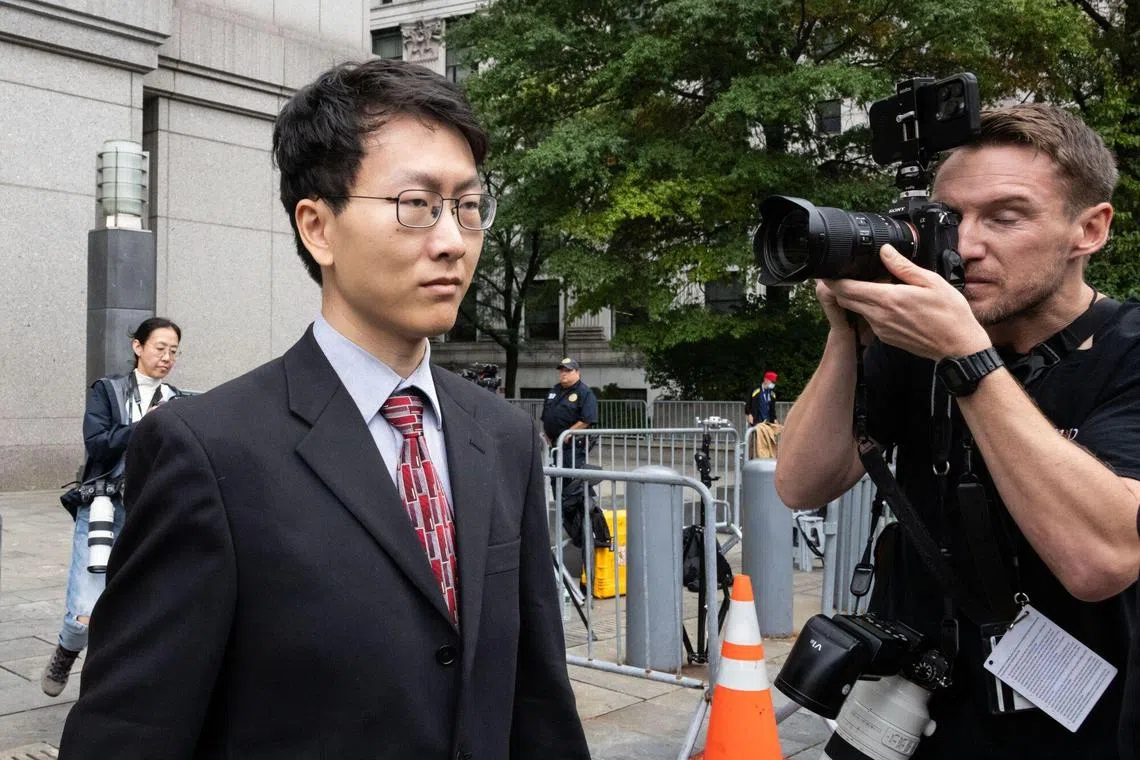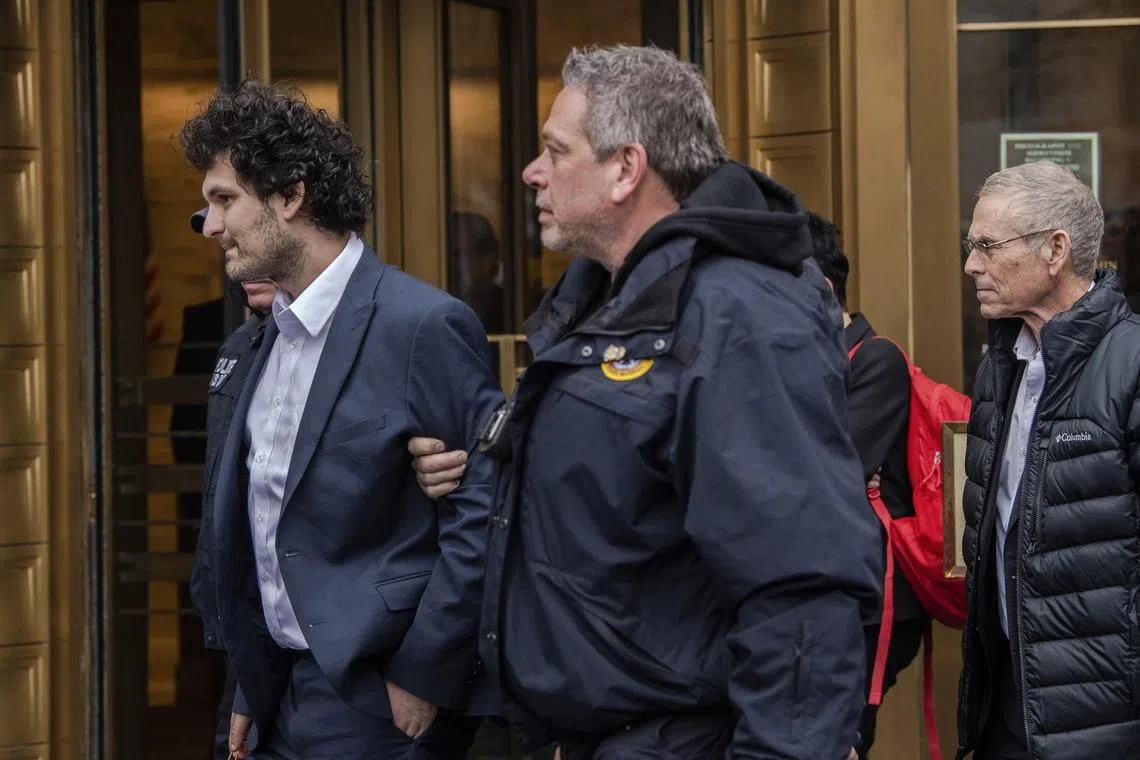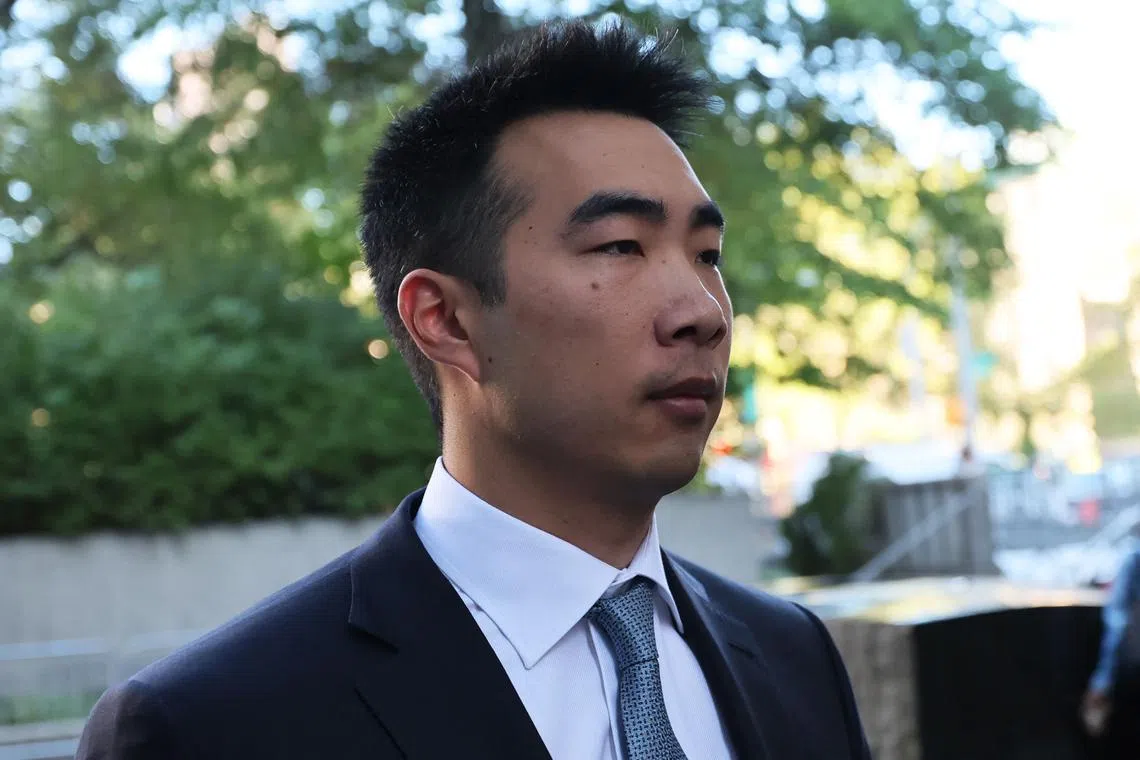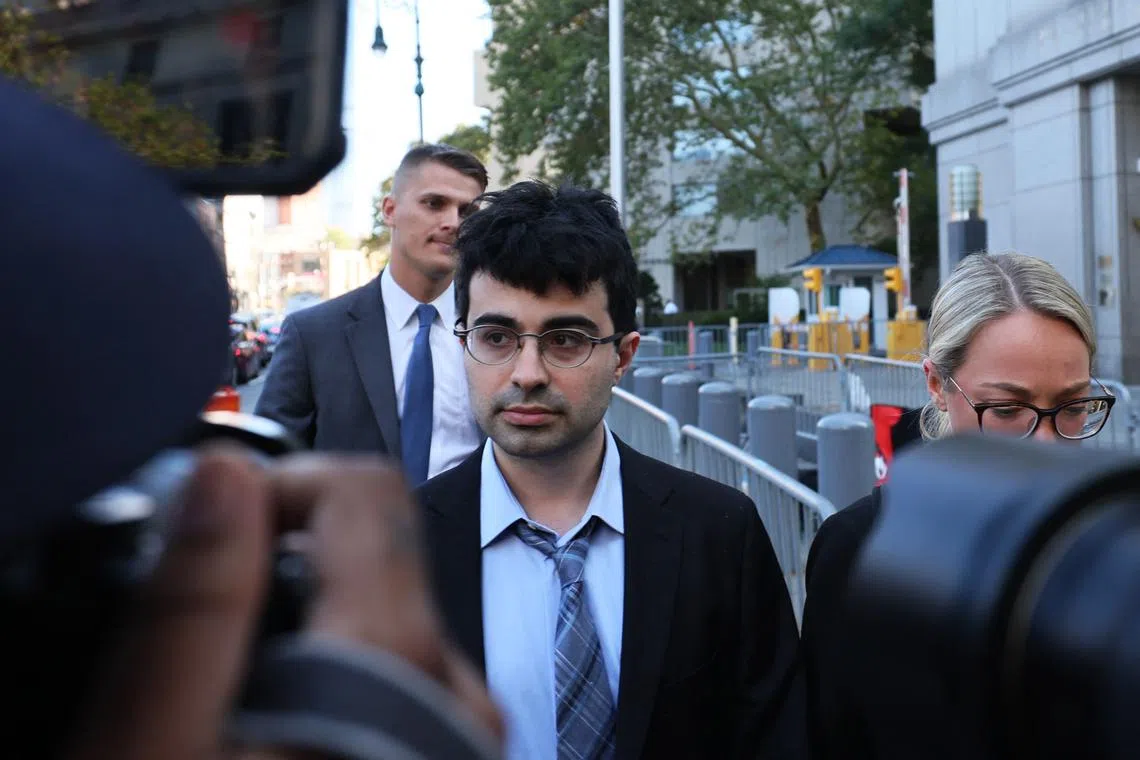‘FTX was not fine’: Co-founder Wang says Bankman-Fried lied in tweet
Sign up now: Get ST's newsletters delivered to your inbox

Gary Wang exiting court in New York on Oct 6, where he provided dramatic descriptions of FTX’s last days.
PHOTO: BLOOMBERG
Follow topic:
NEW YORK – A few days before FTX filed for bankruptcy,
Bankman-Fried’s FTX co-founder, Gary Wang, testified on Friday that was a lie.
“FTX was not fine, and the assets were not fine,” Wang, 30, said in his second day as a prosecution witness in Bankman-Fried’s fraud trial in a Manhattan federal court.
In more than four hours on the stand, Wang provided dramatic descriptions of FTX’s last days and painstaking detail on how he and Bankman-Fried, 31, allegedly implemented a multibillion-dollar scheme that made the exchange’s collapse inevitable.
Wang, who pleaded guilty last December
The resulting “special advantage” allowed Alameda Research, an affiliated hedge fund, to borrow essentially unlimited funds from FTX customers. By autumn 2022, Alameda had borrowed as much as US$14 billion (S$19 billion) from FTX, an amount it could not repay.
He knew it was wrong, said Wang.
“The money belonged to customers, and the customers did not give us permission to use it for other things.”
Wang’s testimony goes to the heart of federal prosecutors’ case against Bankman-Fried. They accuse him of orchestrating a scheme to fraudulently transfer funds to Alameda, creating a massive shortfall that led to both companies’ bankruptcies.
Wang is one of the government’s three star witnesses, along with former Alameda chief executive officer Caroline Ellison, who is also Bankman-Fried’s former girlfriend, and former FTX engineering chief Nishad Singh. Prosecutors said on Friday that Ellison would testify next week.
The long friendship between Wang and Bankman-Fried, who first met at a high school maths camp and were roommates at the Massachusetts Institute of Technology, is an additional, though largely unspoken, dimension to the former’s testimony.
On both Thursday and Friday, Wang avoided making eye contact with Bankman-Fried as he walked through the courtroom towards the witness stand.

Former crypto mogul Sam Bankman-Fried (left) allegedly implemented a multibillion-dollar scheme that made the exchange’s collapse inevitable.
PHOTO: NYTIMES
Under questioning on Friday by Assistant US Attorney Nicolas Roos, Wang testified about the secret mechanisms that permitted funds to flow from FTX to Alameda.
Wang said Bankman-Fried asked that a backend “allow negative” balance feature be added for Alameda. Wang said most users were only able to draw from amounts they had deposited.
Some big customers were given lines of credit at FTX, Wang said. But no one besides Alameda had a credit line of more than US$1 billion, and most were much smaller, in the millions of dollars, according to Wang. Alameda’s was US$65 billion, he said.
Bankman-Fried also directed that Alameda be exempted from liquidation rules that applied to other FTX accounts, Wang said.
He explained that accounts that were in danger of going into the red had their positions sold off to a market maker before that could happen. Wang said the feature existed to protect the exchange and other customers.
Better books
But Bankman-Fried did not want this protection to apply to Alameda, Wang said, and he also occasionally used that special privilege to clean up FTX’s books.
Wang described one instance in which Bankman-Fried asked for Alameda to take a loss of hundreds of millions of dollars instead of the exchange’s backstop insurance fund, which did not have sufficient funds.
According to Wang, it was better for Alameda to take such losses because its books were less public than FTX’s.
On cross-examination, Bankman-Fried lawyer Christian Everdell tried to suggest that the special privileges Alameda enjoyed on FTX were tied, at least in part, to its role as a market maker and as a large customer of the exchange.
The defence will continue its questioning of Wang on Tuesday.
Wang’s description of special treatment for Alameda flies in the face of FTX’s public stance that the exchange treated customers equally, prosecutors allege.
On Thursday, Mr Matt Huang of crypto venture capital firm Paradigm, an investor in FTX, testified that his firm was aware of the relation between Alameda and the exchange but was reassured that there was no preferential treatment.
Mr Huang said it would have been “a concern” if he had known Alameda was not subject to liquidation rules.
“It would’ve meant Alameda could trade with leverage on the platform and could incur negative balances that would need to be repaid somehow,” Mr Huang said, adding, “Given crypto prices are volatile, the business could be insolvent. It would also be damaging to the brand and customers’ trust.”

Mr Matt Huang of Paradigm, an investor in FTX, testified that his firm was aware of the relation between Alameda and the exchange but was reassured that there was no preferential treatment.
PHOTO: AFP
Shutting down Alameda
On Friday, Mr Roos showed jurors a July 2019 tweet in which Bankman-Fried said Alameda was a liquidity provider on FTX and that its account was just like everyone else’s. The prosecutor noted that it was the same day that Alameda was given its “allow-negative” privilege.
Mr Adam Yedidia, another MIT classmate who joined FTX, testified on Wednesday
“It concerned me,” Mr Yedidia said. “It seemed like a lot of money for Alameda to be owing FTX. And I wanted to be certain that Alameda could repay that debt.”

Mr Adam Yedidia testified on Wednesday that he discovered the scale of Alameda’s borrowing and confronted Bankman-Fried in June 2022.
PHOTO: AFP
But it was not the massive liability but the prospect of a Bloomberg News article on the possible conflicts of interest in Alameda’s relationship with FTX that spurred Bankman-Fried to consider taking action, Wang testified.
Bankman-Fried organised a September 2022 Signal chat that also included Ellison and Singh in which he suggested shutting down Alameda, Wang testified. But Bankman-Fried backed off the idea when he realised that Alameda could not repay the US$14 billion it owed FTX.
Two months later, shortly after FTX’s bankruptcy filing, Wang said Bankman-Fried asked him again to figure out a way to move funds, this time to put them out of reach of the US proceeding.
Company lawyer Ryne Miller had told them no assets could be transferred, but Bankman-Fried said to ignore him, Wang testified.
Wang said he went to prosecutors on Nov 17 and told them he wanted to cooperate. BLOOMBERG

